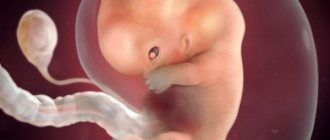During pregnancy, the color, texture, and volume of vaginal discharge change. This usually does not indicate any dangerous process, but it also happens that the cause of the discharge is an infection or pregnancy pathology.
The most striking change, besides the increase in volume, which is often one of the first signs of pregnancy, is the change in color of vaginal discharge. The secretion may be white or translucent, yellowish-green, grey, brown, pink or even red.
Healthy vaginal discharge is translucent or whitish and does not have a strong odor. However, if their appearance has changed, you should consult a gynecologist. For example, voluminous, translucent, jelly-like discharge may indicate premature birth.
Other possible causes of bleeding in early pregnancy
Bleeding during early pregnancy may be due to causes other than implantation. If you have heavy bleeding in early pregnancy with or without cramping or pain, see your doctor.
Some of the other causes of bleeding in early pregnancy are:
- Intimate relationships.
May be one of the possible causes of bleeding in early pregnancy because the cervix is very sensitive at this stage. - Ectopic pregnancy
. This is a condition in which an embryo implants and develops somewhere else outside the uterus, such as the fallopian tubes, abdomen, ovaries, or cervix (the lower part of the uterus that connects to the vagina). As a result, vaginal bleeding develops, accompanied by pain in the pelvic area or cramps (especially one-sided), dizziness, nausea and vomiting. This is a life-threatening condition and requires emergency medical attention. - Threat of miscarriage
. In this condition, the fetus is still inside the uterus, but the final outcome of the pregnancy is in doubt. Threatened miscarriage can occur due to infection, use of certain medications, or injury. - Complete miscarriage.
It is estimated that miscarriages occur in approximately 10-25% of all clinically recognized pregnancies. Thus, a miscarriage can cause bleeding in the early stages of pregnancy at 4 weeks. In addition to vaginal bleeding, other symptoms of miscarriage include cramping and pain in the lower back or abdomen, and discharge of blood with clots from the vagina. - Molar pregnancy
. Molar pregnancy is a rare pregnancy complication in which an abnormal mass of cells develops in the uterus rather than the baby. In addition to bright red or dark brown vaginal bleeding, the condition causes severe vomiting and nausea, prolapse of cysts (that look like grapes) from the vagina, and pelvic pain. - Cervical problems.
Cervical problems, including cervical inflammation, abnormal growths or infection of the cervix, can also cause bleeding in the early stages of pregnancy. - Infections
. Any type of vaginal or cervical infection or sexually transmitted disease (STD), such as herpes, chlamydia or gonorrhea, can cause bleeding similar to bleeding in early pregnancy.
Pink color of discharge
Pink vaginal discharge is considered normal and common in non-pregnant women. If this symptom appears in a pregnant woman, this is abnormal. In the first weeks and last days of pregnancy, this may be a sign of miscarriage or premature birth. Pinkish discharge can also occur during an ectopic pregnancy.
Pink discharge
However, if pink discharge appears and disappears immediately, there is no need to panic. A study conducted by British scientists on 4,500 women found that a small amount of pink in the discharge over 1-2 days was not associated with a higher risk of spontaneous abortion.
Can I take a pregnancy test during implantation bleeding?
Yes, you can take a pregnancy test even if you are bleeding. Home pregnancy tests measure levels of the hormone human gonadotropin (hCG) in the urine. This hormone is produced only during pregnancy, with the exception of certain diseases.
If you take a home pregnancy test according to the directions on the package, the results are usually accurate. During implantation bleeding, the pregnancy test will be positive, as in a pregnancy without bleeding.
Pregnancy test
It is ideal to wait one week after implantation bleeding when testing early in pregnancy, as the results will be more accurate by then. If the pregnancy test results are positive, you should contact your gynecologist to confirm the results by taking a blood test for hCG and undergoing an ultrasound.
Tests to be taken
You should definitely visit a doctor to rule out the development of serious diseases. To prescribe the correct treatment, the doctor needs to find out the nature of the dark brown discharge. To do this, he will conduct an examination on a chair using a special gynecological speculum, find out the presence of redness, rashes and ulcers, and prescribe a number of additional laboratory tests that will help make the correct diagnosis and prescribe effective treatment.
Necessary tests:
— A smear on the flora determines what flora is present in the vagina and what exactly caused the appearance of brown discharge and inflammation.
— Urine and blood analysis allows you to determine hormonal imbalances.
-Ultrasound.
— Histological studies are aimed at detecting cancer cells in women.
Risk of bleeding in early pregnancy for mother and baby
The consequences and risks of bleeding in early pregnancy depend on the cause of its occurrence and whether it can be treated or not.
- Ectopic pregnancy
. This is a pathological pregnancy that requires immediate intervention. With proper treatment, the prognosis for an ectopic pregnancy for the mother is good, but carrying such a pregnancy to term is impossible. - Threatened abortion
. With timely treatment, there is a 50% chance of a normal pregnancy and birth of a child. If during an examination an ultrasound of the uterus shows a fetal heartbeat, then the chances of a normal pregnancy are 75 - 90%. - Complete miscarriage
. Risks for a mother who has not consulted a doctor are the preservation of remnants of the fertilized egg in the uterus. Provided the examination is completed and, if necessary, the uterus is cleaned, the risks for the woman are minimal. - Molar pregnancy
. In this type of pregnancy, there is no formation of the fetus, therefore there is no true pregnancy. Molar pregnancy can have serious complications, including a certain type of cancer that requires early treatment.
What happens to the embryo
In the fourth week, intensive cell division slows down, the division of the germinal disc begins, the formation of the child’s internal organs and external germinal organs.
Structure of the embryo.
The germinal disc is divided into germ layers (special layers of cells), which during development are transformed into certain groups of organs, systems and tissues of the child.
- The outer layer of cells (ectoderm). The cells of the outer germ layer form skin, hair, nails, teeth, eyes, nose and ears. The neural tube of the spinal cord and the entire nervous system of the fetus are formed from these same cells.
- The middle layer of cells (mesoderm). The cells of the middle layer are responsible for the development of the heart, blood vessels and circulatory system, the formation of muscle tissue, the formation of the kidneys, gonads and skeleton of the child.
- Inner layer of cells (endoderm). The organs of the respiratory and digestive systems, liver, lungs and bladder will be formed from the cells of the inner layer.
Extraembryonic organs.
In the fourth week of pregnancy, the amnion, chorion and yolk sac are formed. In the process of further transformation, the amnion will become an amniotic sac containing amniotic fluid. The bladder protects the embryo from damage and prevents the fetal tissue from drying out. At the same time, the umbilical cord is formed. The chorion transforms into the placenta. The cells of the placenta, with the help of chorionic villi, are embedded in the inner lining of the uterus. Starting from the twelfth week, the placenta will function as an independent organ. The yolk sac provides the embryo with a nutritional supply and begins to produce red blood cells.
It is important to note that the male genes of the embryo are responsible for the formation of extraembryonic organs.
When should you contact a gynecologist?
It is extremely important to see your doctor if you have abnormal bleeding or if a pregnancy test confirms your pregnancy. Although light bleeding during early pregnancy is nothing to worry about, you should still visit your gynecologist to make sure everything is going well.
Bloody discharge
Additionally, if your pregnancy test results are positive, you should see your doctor to confirm the test results and decide whether you will continue with your pregnancy or choose to terminate. Early stages of abortion make it possible to perform an abortion with pills, without surgical intervention.
You should also see your doctor if you have heavy bleeding early in pregnancy, as this may indicate a life-threatening condition.
MAKE AN APPOINTMENT
[contact-form-7 id=”296" title=”Untitled”]
Abortion and contraception clinic in St. Petersburg - department of the medical gynecological association "Diana"
Make an appointment, tests or ultrasound via the contact form or by calling +8 (812) 62-962-77. We work seven days a week from 09:00 to 21:00.
We are located in the Krasnogvardeisky district, next to the Novocherkasskaya, Ploshchad Alexander Nevsky and Ladozhskaya metro stations.
The cost of a medical abortion in our clinic is 3,300 rubles. The price includes all pills, an examination by a gynecologist and an ultrasound to determine the timing of pregnancy.
Nutritional Features
Proper nutrition during pregnancy provides mother and baby with all the necessary microelements and vitamins. A balanced menu, taking into account the costs of bearing a baby, will help a woman maintain her figure and give everything the new body needs. In the fourth week of pregnancy, the embryo develops internal organs and systems and begins to receive all vital substances from the mother. Now a woman’s nutrition means caring for her baby. The diet should contain foods high in important microelements and vitamins:
- Iron.
To maintain hemoglobin at a normal level, a sufficient amount of this element is necessary. Hemoglobin carries oxygen to tissues, and a decrease in its concentration in the blood leads to fetal hypoxia (oxygen starvation). Iron is found in red meat, fish, eggs (yolk). - Protein.
It is necessary for the growth and development of the fetus. Protein is the building material of embryonic cells. It is found in fish, meat, nuts, and seeds. - Fats.
These substances are also involved in the construction of cells and are a source of energy. It is important to combine animal and vegetable fats in your diet. - Calcium.
During pregnancy, a woman's body undergoes a change in bone tissue with a decrease in its mineral density. To compensate for these losses, you need to consume enough calcium. It is also necessary to take into account the formation of the baby’s skeleton. Calcium can be obtained from dairy products, almonds, and leafy greens. - Complex carbohydrates.
Complex carbohydrates include whole grains, legumes, and vegetables. Carbohydrates maintain energy balance. If the body does not have enough energy, proteins necessary for the development of the fetus go into the “furnace”. - Alimentary fiber.
Fiber is needed to normalize intestinal motility. Eating enough vegetables, herbs and fruits will ensure normal functioning of the gastrointestinal tract. - Water.
It is important to drink enough clean water. - Vitamins.
Now there is a large selection of ready-made vitamin complexes for pregnant women. Your gynecologist will help you choose the right one.
While maintaining correct eating habits, you should exclude or limit some foods while pregnant:
- Alcohol.
Any alcoholic drinks must be avoided for the entire duration of pregnancy. This is especially important in the first trimester, when the embryo is actively developing and the nervous system and brain are forming. - Canned food.
For long-term storage, a large number of preservatives, stabilizers and other chemical products are used. - Salt.
It is advisable to reduce the consumption of salty foods as much as possible. Salt retains water, puts additional stress on the kidneys and leads to swelling.










